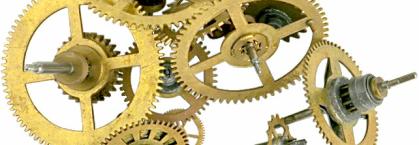How To Install A New Horolovar Mainspring
As a mechanical clock’s source of power, it is very important not to overlook the mainspring when overhauling a movement. Many a novice has been tempted to squirt a few drops of oil into the cap’s drain hole, and call the job done. But this does nothing to address the energy robbing, gummed up, sticky goo possibly lurking inside the barrel, or the condition of the mainspring itself. The mainspring must be removed from the barrel, and either replaced with a new mainspring, or cleaned, inspected, and re-lubed. Since the old mainspring has likely sat tightly coiled in the barrel for 60 years or more, I recommend replacing it with a new one. This helps to ensure that the clock you're spending your time and effort repairing will run like new, and for a full 400 days. The best way to remove a mainspring, and the only safe and reliable way to rewind and reinsert a mainspring, is to use a mainspring winder. But a good mainspring winder that will work on hole end mainsprings (as are used on 400 day anniversary clocks) is expensive. These instructions assume that you do not have a mainspring winder, and will be replacing your mainspring with a new Horolovar mainspring.
To get to the mainspring barrel, the movement must be disassembled. Before you do that, the mainspring must be unwound, or ’let down’. Always assume that a clock’s mainspring is fully wound when you begin to work on it. Never attempt to disassemble the movement without first ensuring the mainspring is completely unwound. Doing so will almost certainly cause extensive damage to the movement, and may injure you or others close by if metal pieces go flying.
Mainspring let down tools are used to safely unwind the powerful mainspring. There are two types of let down tool. Both have a round handle that allows it to smoothly turn in your hand while the mainspring unwinds. One type is designed to fit directly over the winding arbor just like the clock’s key does. This type is generally more expensive, because you need a different size tool (or insert) for every size winding arbor you might run into. The other type is designed to fit over your clock's key, with a round hole and two slots for the key to slide into. Insert the let down tool (or key and tool) over the winding arbor. Firmly grasp the handle, and turn the tool counter clockwise just a hair so that pressure is removed from the ratchet wheel and click. (The ratchet wheel is a brass or steel disk shaped object, with teeth that point in one direction. It has a hole in the middle, and fits over the mainspring arbor. On some clocks, it is located on the back of the back plate, and on others, it is located between the plates. The click is steel, and usually black. It pivots on the screw in it's center. One side of the click is pressed between two teeth of the ratchet wheel, held in place by the click spring.) Lift the click away from the ratchet wheel, then slightly release the pressure of your grip on the tool to allow the tool to slowly rotate in your hand until the mainspring has fully unwound. (Some of you may be thinking, ‘Hey, I can do this with just the key. I don’t need a let down tool!’ You may pull it off once or twice if you‘re lucky. But as soon as the key gets away from you, busting your knuckles, while the runaway mainspring shears a few teeth off your barrel, along with a pivot or two elsewhere in the movement, you’ll realize it would have been cheaper - and less painful - to have bought the tool.)
A mainspring under tension is very powerful, fully capable of lacerating and bruising unprotected skin. Even though the mainspring is no longer tightly wound inside the barrel, it is still under a lot of tension, which is held in check by the barrel itself. Wear a pair of thick leather gloves, an old jean jacket, and a pair of safety glasses for protection. First, open the barrel. They can sometimes be stubborn. The best way is to hammer the rounded end of the arbor with a rubber mallet (to avoid damaging the pivot) until the cap pops off. The cap can also be pried off with a screwdriver wedged into the drain hole, but doing so can warp the cap. Remove the winding arbor by turning clockwise, then pulling it out once the arbor’s hook has disengaged from the spring. Holding the barrel in one hand, take a pair of needle nose pliers and pull the center coils out a few inches. Be careful not to pull too hard or fast. Pull them out to the point where you can grasp the coils with your hand without using the pliers. Carefully pull and twist, and the spring will slowly emerge into your hand. Take your time, and concentrate on keeping the spring under control. If it does get away from you, your clothing should protect you. After the spring has emerged, unhook the end from the hook on the inside of the barrel.
Clean the inside of the barrel and cap. A rag dipped in acetone works very well to dissolve the old grease deposits.
Horolovar mainsprings are pre-wound to a diameter smaller than the inside of the barrel, but they are not lubricated. I recommend using a premium brand of fully synthetic 5W 30 or 40 motor oil. Using a clean rag, lightly coat the inside of the barrel and cap, the outer coil of the mainspring, and both exposed edges of the coils. Capillary action will distribute the oil evenly when the spring is in use.
Wearing your protective gear, insert the mainspring into the barrel as far as the wire that keeps the spring tight will allow. Remember that the clock is wound counter clockwise, so the coil must be oriented so that it will tighten around the winding arbor in a counter clockwise direction. Holding the barrel with the teeth toward your palm, and your fingers around the exposed mainspring, use your free hand to untwist the wire with a pair of pliers. Then slowly pull the wire free. Insert the winding arbor and twist counterclockwise to engage the hole in the inner coil of the mainspring. Occasionally, you may find that the hook on the arbor will not catch the hole in the mainspring. If this happens, first make sure the hook on the arbor is undamaged. If it looks okay, then grasp the end of the mainspring with a pair of needle nose pliers and twist to tighten the inner loop to a smaller diameter. (The ends of the mainspring are not tempered, and can easily be bent.) Conversely, you may find that the inner coil is too tight for the body of the winding arbor to fit. In this case, open the inner coil with your needle nose pliers. Slide the cap over the winding arbor, and grasp it with your fingers of the hand palming the barrel. While squeezing your fingers to press the cap towards the barrel, insert your clock’s key and turn counterclockwise. As more force is applied, the mainspring will seat itself completely into the barrel, and the outer hole on the mainspring will catch on the hook inside the outer edge of the barrel. Once that happens, use your pliers to squeeze the cap back into place. Cover it with leather or a thick cloth to prevent tool marks on the brass.


